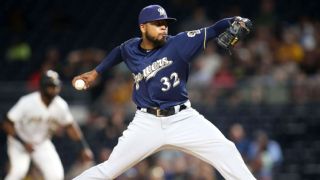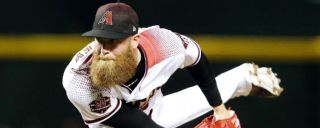|
As the All-Star Game approaches and potential rosters begin to take shape, one question predominates: How is baseball going to find room for all those worthy pitching candidates? It's hard enough to choose when almost 30 starters have sub-3.50 ERAs and unheralded closers are putting up staggering numbers (Edwin Diaz and Blake Treinen are two who come to mind). MLB teams are also using a record 4.23 pitchers per game, which means starters are being pulled earlier and more heavy lifting is required of pitchers in the sixth, seventh and eighth innings. Dellin Betances and Andrew Miller have made a combined six All-Star teams since 2014 while posting dominant numbers in setup roles. But they're not alone. David Robertson, Kelvin Herrera, Darren O'Day and Brad Brach are among the other established names in that club. And Tyler Clippard and Pat Neshek each made two All-Star teams while someone else was pocketing the bulk of the saves. Sometimes the one-representative-per-roster rule or a strong three months helps a surprise non-closer make an All-Star Game. Jesse Crain, Aaron Crow, Evan Meek and Jonny Venters (pre-Tommy John surgeries) all fall under this umbrella. So which factors should the players and the commissioner's office take into account this year when they assess All-Star pitchers -- and more specifically, relievers? "The one thing I would say is, we shouldn't look at relievers and say the guy with the most saves belongs in the All-Star Game,'' said Milwaukee manager Craig Counsell. "I do think it's important that the relievers you consider are pitching in leverage spots in the game. They just don't have to have the 'S' behind their name.'' Josh Hader, who is averaging almost 18 strikeouts per nine innings for the Brewers, has been so dominant in a multi-inning shutdown role that he's immune from the debate. If Hader's fellow players don't designate him an All-Star, they should be stripped of the vote and required to stand in the box against him one-by-one as punishment. The relievers listed below -- most of whom pitch for National League clubs -- generally have great peripherals and lots of holds. They produce in high-leverage situations, strand a large percentage of inherited runners and rank high in relief pitcher WAR. They don't stand a great chance of making it to Washington, D.C., for the All-Star Game on July 17. But they at least merit a place in the conversation. Jeremy Jeffress, Brewers  Key stats: Jeffress has a 0.76 ERA and a 0.84 WHIP in 35 appearances. His 1.9 WAR ties him with teammate Josh Hader for second-best among relievers in baseball behind Colorado's Adam Ottavino. With 77 strikeouts in his first 38 2/3 innings, Hader is a lock to make his first All-Star team. But is there room on the roster for his main wingman? As every profile of Jeffress duly notes, he has overcome a checkered history to reach this point. It includes two suspensions (50 games and 100 games) for marijuana use in the minors, a DWI arrest in Texas and medical struggles with juvenile epilepsy. Jeffress did not pitch well in 39 games with the Rangers in 2017. But the Brewers saw enough to reacquire him in a late July trade, and they re-signed him to a one-year, $1.7 million deal with two club options in December. Jeffress throws a mid-90s fastball, a low-80s curve and a split-finger-change that dives in increments of 90 mph. That repertoire has helped make him one of MLB's best redemption stories this season. "A lot is made of how he's comfortable in Milwaukee and he's pitched well here, and I think there's something to that,'' Counsell said. "We've used him in some very big spots, and I think that brings the best out in him.'' Adam Ottavino, Rockies Key stats: Ottavino leads the majors with a 2.0 relief pitcher WAR. Opponents have a slash line of .098/.207/.137 against him. He struck out 52 batters in his first 32 2/3 innings. The Rockies spent a record $106 million on the bullpen during the offseason, and the results have been less than stellar. Bryan Shaw and Jake McGee have been disappointing, and Wade Davis hit a rough patch after a strong start and has logged a 12.15 ERA and a .321 batting average against in June. With the exception of a three-week trip to the disabled list with an oblique injury, Ottavino has been the rock in Colorado's pen. His performance is in large part a tribute to an offseason of hard work and introspection. As FanGraphs' Travis Sawchik detailed in a recent profile, Ottavino rented out a Manhattan storefront and turned it into an experimental learning lab over the winter. He also visited Driveline, a data-driven player-development facility in suburban Seattle, and spent $16,000 for a high-speed camera to help analyze his mechanics. Ottavino tinkered with his pitch mix, as well. He's throwing his fastball 38 percent of the time this season compared to 50 percent a year ago, and he has filled the void with increased use of his slider and cutter. "He was really studious about his delivery, from what the Driveline people did and what he did on his own,'' said Rockies manager Bud Black. "Release point. Spin rate. Finger pressure. He wanted to build his own personal library by himself, and when he started getting ready for spring training, to put it in motion. He came into the spring as prepared as any time in his career -- physically, mentally and fundamentally.'' Dan Winkler, Braves Key stats: Winkler has 40 strikeouts and eight walks this season. Right-handed hitters are batting .119 (8-for-67) against him, and he has held opponents to a .125 batting average in high-leverage situations. Winkler's comeback story doesn't quite compare to the one crafted by Jonny Venters, who returned to pitch this year in Tampa Bay after three elbow reconstructions. But it's inspirational nevertheless. He's a former 20th round draft pick by Colorado and a 2014 Rule 5 pick by Atlanta, and he has overcome a Tommy John surgery and a fractured bone in his left elbow during a frightening sequence in 2016. "It blows me away that he can throw a baseball after what he's experienced," Braves manager Brian Snitker told Steve Hummer of the Atlanta Journal-Constitution. "I saw the X-ray and it blows me away even more. It wasn't pretty. Like a Home Depot ad for hardware." A stacked Atlanta contingent might be the biggest obstacle to Winkler's All-Star bid. Freddie Freeman, Nick Markakis and Ozzie Albies are leading the fan balloting at their positions, and Sean Newcomb and Mike Foltynewicz both rank among the top 10 in starter ERA. As good as Winkler has been, Atlanta closer Arodys Vizcaino is also having a strong season. There's only room for so many Braves to go to Washington. Tony Watson, Giants Key stats: Watson has a 40-6 strikeout-to-walk ratio and a 1.3 WAR -- the same as Mariners closer Diaz. While Shaw, McGee, Tommy Hunter, Neshek and others were cleaning up in free agency, the Giants waited out Watson and signed him to a three-year, guaranteed $9 million deal that could increase to $21 million with escalators and performance bonuses. He has been a godsend for manager Bruce Bochy's bullpen. "No fear,'' said a scout. "No panic. Flat-line approach. He does a hell of a job pitching on the thumbs and off the cup of the bat. There's a lot of sneak in his arm action and his delivery. He jumps ahead, stays ahead and puts hitters away. He just throws quality strike after quality strike.'' Watson's velocity is a career low 92 mph this season, but he has compensated with increased use of his slider and changeup. His 13.6 swinging strike rate is the highest of his career. Bochy told reporters Tuesday that Watson and Sam Dyson are the top candidates to close games for San Francisco while Hunter Strickland sits out six to eight weeks with a self-inflicted broken pinkie on his pitching hand. Kyle Barraclough, Marlins Key stats: Barraclough has allowed nine hits in 32 1/3 innings this season. Opponents are 9-for-104 (.087) against him, with a slash line of .087/.220/.173. The Marlins are probably going to land only one All-Star spot, and it's likely to go to J.T. Realmuto, who might be the best all-around catcher in baseball this season. But Barraclough has been a bullpen force for a team that doesn't have many leads to protect. After more than two years in a setup role, Barraclough took over for Brad Ziegler at closer three weeks ago and has yet to allow a hit in June. He has relied less on his slider and more on his changeup, and he's thriving even though his fastball velocity is down about 2 mph from two years ago. Barraclough could be a nice trade chip if the Marlins decide to continue their offseason rebuild in advance of the July 31 non-waiver deadline. He's not eligible for free agency until 2021, so he is likely to attract a bigger haul of talent than the Royals received from Washington in the Herrera deal. Archie Bradley and Yoshihisa Hirano, Diamondbacks Key stats: Other than Hader, Bradley has pitched more high-leverage innings (18 2/3) than any setup man in baseball. Opponents are batting .197 against him. Hirano has limited opponents to a .063 batting average in high-leverage situations. That's second-best among MLB relievers to Carl Edwards Jr. of the Cubs. Bradley and Hirano have combined with Andrew Chafin and T.J. McFarland to give the Diamondbacks the best bullpen ERA in the majors. Bradley isn't quite as dominant as last year, when he was tied for second among relievers with a 3.6 WAR. One possible explanation: He suffered a cracked nail on his right forefinger during the offseason, and he has had to resort to visiting the nail spa regularly to get fake fingernails that make the pain tolerable enough for him to throw his curveball. He remains a workhorse, nevertheless. Hirano, who saved 156 games over 12 seasons with the Orix Buffaloes in Japan, pronounced himself "honored'' to be a Diamondback when he signed a two-year, $6 million free-agent deal with the team in December. He has been a nice fit in the Arizona clubhouse and a challenge for hitters with his deceptive delivery and fastball-splitter combination. Seranthony Dominguez, Phillies Key stats: Since his arrival from the minors on May 7, Dominguez has logged a 1.61 ERA and a 0.58 WHIP. Lefties are batting .118 against him, and righties are only slightly less helpless at .146. The Phillies spent more than $34 million on multiyear deals for Neshek and Hunter during the offseason. Hunter has put up so-so numbers, and Neshek has spent the entire season on the disabled list, while Hector Neris, last year's closer, was so bad the Phillies recently demoted him to Triple-A Lehigh Valley to regain his confidence and faith in his splitter. The void in the bullpen created an opportunity for Dominguez, the latest find from international scouting director Sal Agostinelli and his industrious group of Latin American talent evaluators. Dominguez's even temperament, 98 mph fastball and wipeout slider appear to make him optimal closer material. But Phillies manager Gabe Kapler has resisted the temptation to name Dominguez his closer and used him as a shutdown option at various stages of the game. Dominguez recorded more than three outs in eight of his first 18 appearances. Others of note: Steve Cishek and Edwards Jr., Cubs; Chris Devenski and Hector Rondon, Astros; Kirby Yates and Craig Stammen, Padres; Joe Jimenez, Tigers; Jared Hughes and Amir Garrett, Reds; Jordan Hicks, Cardinals; Edubray Ramos, Phillies; Richard Bleier, Orioles.
|


